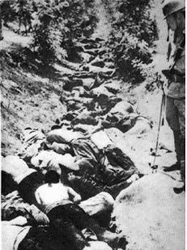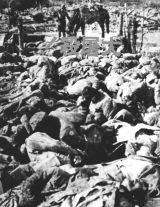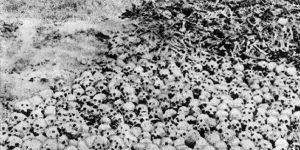indisputable evidence of the atrocities committed by the Japanese in Nanjing.
After the initial massacre had run its course, the streets within the city
were strewn with corpses, baggage, parcels, and all sorts of other
miscellaneous items. Not only were cars unable to pass through, even
making one's way by foot was made difficult by the mess. The Japanese
began negotiations with the International Committee [for the Nanking
Safety Zone]; they wanted the International Committee to assist in
clearing the corpses from the streets. The International Committee
assembled a corps of men from the refugee camp, issued them white badges,
and organized them into several brigades to collect the corpses. Under the
supervision of Japanese soldiers from the engineering corps dispatched to
the scene, they began the work of clearing away and burying the corpses.
Because there was an inadequate number of men assigned to the task,
initially the work of clearing the streets was carried out only on the main
thoroughfares. On the other streets, where many corpses and miscellaneous
items had accumulated, they used clothing and other assorted materials to
cover up the corpses until they could be cleared away on another day. A
foreign correspondent witnessed and reported about these piles of corpses
that lined both sides of the Nanjing streets.
In the area near the Nanjing Drum-Tower is the intersection of the roads leading to Peace and Yijiang Gates. The Japanese slaughtered a large number of refugees there, so there was an exceptionally large number of corpses and debris in that area. There were so many corpses that the workers clearing them away had no choice but to move some of them to the nearby Double Dragon and Stone Grandmother Lanes. The corpses were piled up high along both sides of these lanes. The lanes were extremely narrow, so the amassed bodies looked like an edifice constructed of corpses, a veritable wall of flesh. The area became a paradise for wild dogs, stray cats, and rats. Fortunately, the weather that winter was freezing cold, so the corpses did not decompose and it was relatively easy to move them away to be buried.
The brigade in charge of clearing away the corpses transported another pile of bodies to two lanes at the foot of the western face of Dabei Mountain where there was a stretch of wasteland. The corpses were wantonly abandoned there, until a huge number of bodies had accumulated on this spot. A while later, the Japanese transported some of the bodies to Wutai Mountain (the present location of the Wutai Mountain Stadium) where, to get rid of the evidence of their crimes, they doused them with gasoline and set them ablaze. The rest of the corpses were buried in the ground right there on Dabei Mountain, hence the mountain's nickname -- Corpse Mountain -- bestowed upon it by the residents of the area. In 1954, when buildings were being constructed on this site, countless numbers of skeletons were exhumed. According to the locals, there were originally four or five thousand bodies piled up on this spot.
During the first month of 1938, the Japanese were subjected to worldwide condemnation and denunciation for the atrocities they had committed during the Nanjing massacre. The ruling clique in Japan could do nothing but admit that their forces in Nanjing had in fact committed the criminal acts of brutal murder, rape, plunder, arson, and destruction. They hastily recalled Matsui Iwane, along with more than eighty generals and colonels under his command, back to Japan, but not a single one was punished for his crimes. They proceeded to order Nanjing's International Committee to oversee an expeditious and thorough clearing away of all the remaining corpses which had been accumulating inside and outside the city, either by burial or mass incineration.
From the beginning of February they started burying the corpses which lay on the roadsides. Generally, a large pit would be dug and over 100 corpses pitched into the hole. After dirt was dumped on top of the bodies and the pit filled in, the task was considered complete. But some humane organizations participating in these burial tasks kept statistics on where and how many corpses were buried.
In the area near the Nanjing Drum-Tower is the intersection of the roads leading to Peace and Yijiang Gates. The Japanese slaughtered a large number of refugees there, so there was an exceptionally large number of corpses and debris in that area. There were so many corpses that the workers clearing them away had no choice but to move some of them to the nearby Double Dragon and Stone Grandmother Lanes. The corpses were piled up high along both sides of these lanes. The lanes were extremely narrow, so the amassed bodies looked like an edifice constructed of corpses, a veritable wall of flesh. The area became a paradise for wild dogs, stray cats, and rats. Fortunately, the weather that winter was freezing cold, so the corpses did not decompose and it was relatively easy to move them away to be buried.
The brigade in charge of clearing away the corpses transported another pile of bodies to two lanes at the foot of the western face of Dabei Mountain where there was a stretch of wasteland. The corpses were wantonly abandoned there, until a huge number of bodies had accumulated on this spot. A while later, the Japanese transported some of the bodies to Wutai Mountain (the present location of the Wutai Mountain Stadium) where, to get rid of the evidence of their crimes, they doused them with gasoline and set them ablaze. The rest of the corpses were buried in the ground right there on Dabei Mountain, hence the mountain's nickname -- Corpse Mountain -- bestowed upon it by the residents of the area. In 1954, when buildings were being constructed on this site, countless numbers of skeletons were exhumed. According to the locals, there were originally four or five thousand bodies piled up on this spot.
During the first month of 1938, the Japanese were subjected to worldwide condemnation and denunciation for the atrocities they had committed during the Nanjing massacre. The ruling clique in Japan could do nothing but admit that their forces in Nanjing had in fact committed the criminal acts of brutal murder, rape, plunder, arson, and destruction. They hastily recalled Matsui Iwane, along with more than eighty generals and colonels under his command, back to Japan, but not a single one was punished for his crimes. They proceeded to order Nanjing's International Committee to oversee an expeditious and thorough clearing away of all the remaining corpses which had been accumulating inside and outside the city, either by burial or mass incineration.
From the beginning of February they started burying the corpses which lay on the roadsides. Generally, a large pit would be dug and over 100 corpses pitched into the hole. After dirt was dumped on top of the bodies and the pit filled in, the task was considered complete. But some humane organizations participating in these burial tasks kept statistics on where and how many corpses were buried.



